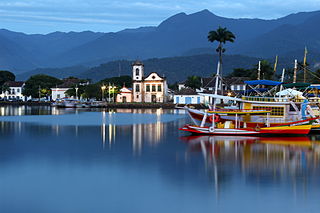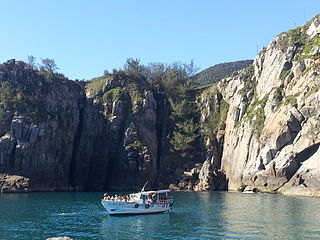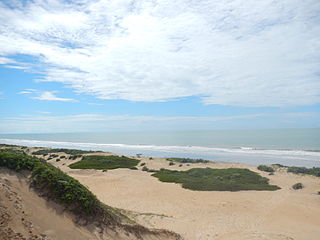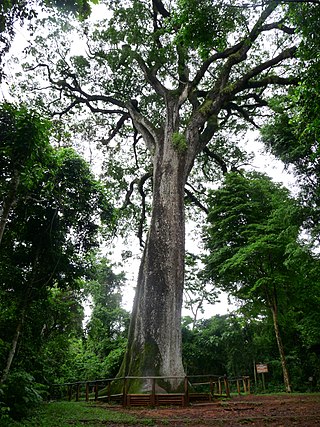Location
The former village of Paraty-Mirim is on the southern coast of the state about 15 kilometres (9.3 mi) from the municipal seat of Paraty. The village was once an alternative to the port of Paraty for shipping gold and conducting other transactions. During the coffee boom it was also a place were slaves were landed, often illegally, for the São Paulo plantations. The village became depopulated during the 19th century. All that remains is a colonial residence, a church dedicated to Our Lady of Conception, and many ruins. The village is protected by the Paraty-Mirim State Park, the Cairuçu Environmental Protection Area and the Juatinga Ecological Reserve.
The Paraty-Mirim State Park covers an area of unusual beauty, with wide slopes covered by abundant vegetation. The park contains the beach, the river and the indigenous reserve of Paraty-Mirim. The ruins have been listed by the National Institute of Historic and Artistic Heritage (IPHAN). The park is contained with the Cairuçu Environmental Protection Area.

Paraty is a preserved Portuguese colonial (1500–1822) and Brazilian Imperial (1822–1889) municipality with a population of about 43,000. The name "Paraty" originates from the local Guaianá Indians' indigenous Tupi language, named for an abundant local fish native to the region. Paraty is located on the Costa Verde, a lush green corridor that runs along the coastline of the state of Rio de Janeiro, in Brazil. Paraty has become a tourist destination, known for its historic town center and the coast and mountains in the region. The historic center of the city, as well as four areas of the Atlantic Forest, were inscribed on the UNESCO World Heritage List in 2019 under the title "Paraty and Ilha Grande".

Angra dos Reis is a municipality located in the southern part of the Brazilian state of Rio de Janeiro. The city is located by the sea and includes in its territory many offshore islands, the largest being Ilha Grande.

Protected areas of Brazil included various classes of area according to the National System of Nature Conservation Units (SNUC), a formal, unified system for federal, state and municipal parks created in 2000.

Cairuçu Environmental Protection Area is a protected area in the south of Rio de Janeiro state, Brazil. It contains an important remnant of the Atlantic Forest biome.

The Costa do Sol State Park is a state park in the state of Rio de Janeiro, Brazil. It protects a number of fragments of coastal areas in the Atlantic Forest biome that are under intense pressure from urban expansion, but that also have considerable tourism potential.
The Guajará-Mirim State Park is a state park in the state of Rondônia, Brazil. It protects an area of savanna forest and transition into rainforest. It is in an area where there is great pressure from loggers and ranchers. A road was illegally cut through the park, apparently by loggers supported by local politicians. This received federal approval after the fact, since it provides access to areas otherwise cut off by flooding of the Madeira River.
The Mata das Flores State Park is a State park in the state of Espírito Santo, Brazil.

The Itaúnas State Park is a state park in the state of Espírito Santo, Brazil. It protects the lower reaches of the Itaúnas River and a strip of marshes, dunes and beaches along the Atlantic coast of the north of the state.
The Rio Roosevelt State Forest was a state forest in the state of Rondônia, Brazil.

The Ilha do Cardoso State Park is a state park on the coast of the state of São Paulo, Brazil. It preserves a large area of Atlantic Forest on the Ilha do Cardoso, an island, and includes marshes and mangroves that form an important breeding area for marine life. Visitors may reach the island by boat and stay in one of the villages. They may visit the beaches or follow trails into the interior, where there are waterfalls and natural pools.

The Vassununga State Park is a state park in the state of São Paulo, Brazil. It preserves an area of interior Atlantic Forest and cerrado, including a huge jequitibá-rosa tree that by some accounts is the oldest tree in Brazil.

The Carlos Botelho State Park is a state park is the state of São Paulo, Brazil. It protects a mountainous area of Atlantic Forest. The park contains more than half of Brazil's remaining population of endangered southern muriqui, the largest primate in the Americas other than man.

The Areia Vermelha Marine State Park is a State park in the state of Paraíba, Brazil.

The Pico do Jabre State Park is a state park in the state of Paraíba, Brazil. It protects the highest peak in northeast Brazil, with a unique montane forest ecosystem combining Atlantic Forest and caatinga elements.

The Rio Vermelho State Park Portuguese: Parque Estadual do Rio Vermelho is a state park in the state of Santa Catarina, Brazil. It protects an area of restinga, dense rainforest and land modified by exotic plantations which is to be restored. The park provides a green space for visitors from the nearby state capital of Florianópolis. It features an ecological trail where visitors may see and learn about wild animals rescued from abuse by the environmental police.

The Juatinga Ecological Reserve is an ecological reserve in the state of Rio de Janeiro, Brazil. It protects a rugged peninsula projecting into the Atlantic Ocern that is mainly covered by Atlantic Forest, and also helps maintain the traditional lifestyle of residents of small villages along the coast.

The Prosa State Park, formerly the Parque dos Poderes, is an urban state park in the state of Mato Grosso do Sul, Brazil. It protects a remnant of cerrado vegetation, and is home to a wildlife rehabilitation center.

The Serra da Tiririca State Park is a state park in the state of Rio de Janeiro, Brazil. It protects an area of rugged terrain on the Atlantic coast with Atlantic Forest vegetation.

Events in the year 2023 in Brazil.
This page is based on this
Wikipedia article Text is available under the
CC BY-SA 4.0 license; additional terms may apply.
Images, videos and audio are available under their respective licenses.

















